|

Phocids have no ears: Phocids are the more highly specialized for aquatic life of the two groups and, unlike otariids, lack external ears and cannot bring their hind flippers under their body to walk on them.
Galumphing on land: They are more streamlined than fur seals and sea lions, and can therefore swim more effectively over long distances than those can. However, because they cannot turn their hind flippers downward, they are very clumsy on land, having to wiggle with their front flippers and abdominal muscles; this method of locomotion is called galumphing.
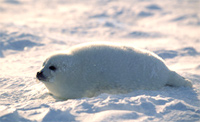 Eared seals live more on the land: The eared seals (or walkinvg seals), family Otariidae, are the fur seals and the sea lions. These are barrel shaped marine mammals, adapted to a semi-aquatic lifestyle. They feed and travel in the water but breed and largely rest on land (or, in some cases, on ice). They are slightly less adapted to the aquatic lifestyle than are the true seals. Eared seals live more on the land: The eared seals (or walkinvg seals), family Otariidae, are the fur seals and the sea lions. These are barrel shaped marine mammals, adapted to a semi-aquatic lifestyle. They feed and travel in the water but breed and largely rest on land (or, in some cases, on ice). They are slightly less adapted to the aquatic lifestyle than are the true seals.

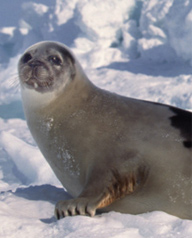 True seals don't bark: Additionally, true seals do not communicate by "barking" like the fur seals and sea lions of family Otariidae. They communicate by slapping the water and grunting. True seals don't bark: Additionally, true seals do not communicate by "barking" like the fur seals and sea lions of family Otariidae. They communicate by slapping the water and grunting.
Efficient, economical movement: While otariids are built for speed and maneuverability in the water, phocids are built for efficient, economical movement. This allows most phocids to make long foraging trips to exploit prey resources that are far from land, whereas otariids are tied to rich upwelling zones close to their breeding sites.
Important fat reserves:
The phocid reproductive cycle is characterized by temporal and spatial separation between feeding and maternal investment; in other words, a pregnant female spends a long period of time foraging at sea, building up her fat reserves, and 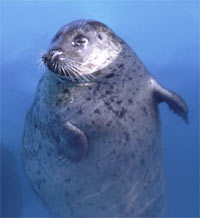 then returns to the breeding site and uses her stored energy reserves to provide milk for her pup. It should be noted that the common seal (harbor seal in the U.S.), Phoca vitulina, does not separate foraging and maternal investment; instead, it displays a reptroductive strategy similar to those of otariids, in which the mother makes short foraging trips between nursing bouts. then returns to the breeding site and uses her stored energy reserves to provide milk for her pup. It should be noted that the common seal (harbor seal in the U.S.), Phoca vitulina, does not separate foraging and maternal investment; instead, it displays a reptroductive strategy similar to those of otariids, in which the mother makes short foraging trips between nursing bouts.
Lactate or eat: Because a phocid mother's feeding grounds are often hundreds of kilometers from the breeding site, this means that she must fast while she is lactating. This combination of fasting with lactation is one of the most unusual and extraordinary behaviors displayed by the Phocidae, because it requires the mother seal to provide large amounts of energy to her pup at a time when she herself is taking in no food (and often, no water) to replenish her stores.
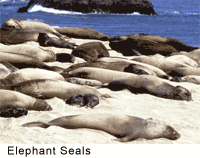 Thick, rich-fat milk: Because they must continue to burn fat reserves to supply their own metabolic needs while they are feeding their pups, phocid seals have developed an extremely thick, fat-rich milk that allows them to provide their pups with a large amount of energy in as small a period of time as possible. This allows the mother seal to maximize the efficiency of her energy transfer to the pup and then quickly return to sea to replenish her reserves. The length of lactation in phocids ranges from 28 days in the Northern Elephant Seal to just 3–5 days in the Hooded Seal. The nursing period is ended by the mother, who departs to sea and leaves her pup at the breeding site. Pups will continue to nurse if given the opportunity, and "milk stealers" that suckle from unrelated, sleeping females are not uncommon; this often results in the death of the pup whose mother the milk was stolen from, as any single female can only produce enough milk to provision one pup. Thick, rich-fat milk: Because they must continue to burn fat reserves to supply their own metabolic needs while they are feeding their pups, phocid seals have developed an extremely thick, fat-rich milk that allows them to provide their pups with a large amount of energy in as small a period of time as possible. This allows the mother seal to maximize the efficiency of her energy transfer to the pup and then quickly return to sea to replenish her reserves. The length of lactation in phocids ranges from 28 days in the Northern Elephant Seal to just 3–5 days in the Hooded Seal. The nursing period is ended by the mother, who departs to sea and leaves her pup at the breeding site. Pups will continue to nurse if given the opportunity, and "milk stealers" that suckle from unrelated, sleeping females are not uncommon; this often results in the death of the pup whose mother the milk was stolen from, as any single female can only produce enough milk to provision one pup.
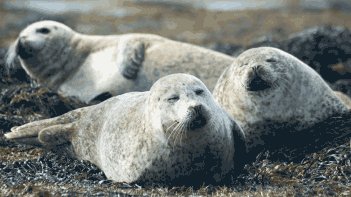

Milk energy: Because the pup receives the milk energy from its mother so quickly, its development is typically not complete enough for it to begin foraging on its own as soon as the nursing period is complete. Seals, like all marine mammals, need time to develop the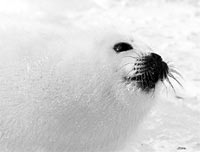 oxygen stores, swimming muscles and neural pathways necessary for effective diving and foraging. Because of this, most phocids undergo a postweaning fast, in which they remain on or near the breeding site and live off of the fat stores they acquired from their mothers until they are ready to begin foraging on their own. These pups typically eat no food and drink no water during the fast, although some polar species have been observed to eat snow. The postweaning fast ranges from 2 weeks in the Hooded Seal to 9-12 weeks in the Northern Elephant Seal. The physiological and behavioral adaptations that allow phocid pups to endure these remarkable fasts, which are among the longest for any mammal, remain an area of active study and research. oxygen stores, swimming muscles and neural pathways necessary for effective diving and foraging. Because of this, most phocids undergo a postweaning fast, in which they remain on or near the breeding site and live off of the fat stores they acquired from their mothers until they are ready to begin foraging on their own. These pups typically eat no food and drink no water during the fast, although some polar species have been observed to eat snow. The postweaning fast ranges from 2 weeks in the Hooded Seal to 9-12 weeks in the Northern Elephant Seal. The physiological and behavioral adaptations that allow phocid pups to endure these remarkable fasts, which are among the longest for any mammal, remain an area of active study and research.
All text is available under the terms
of the GNU Free Documentation License
|